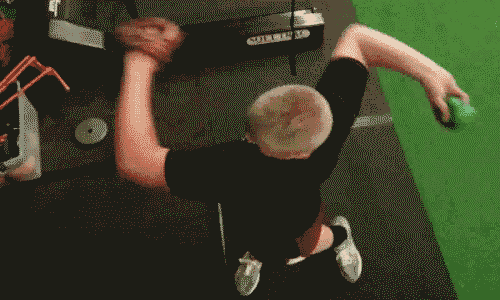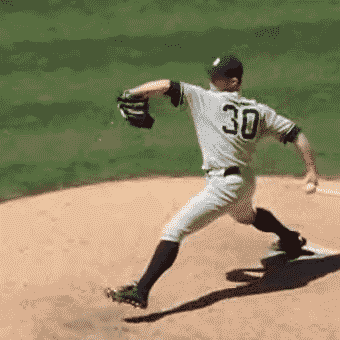Disconnected Pitching Mechanics – A Good Thing?
With the proliferation of tools like the our Plyo Ball ® (a daily training tool for us) and the writings of Paul Nyman’s PCR methods (Posture-Connection-Rotation), it’s also been widely accepted that a disconnected delivery is a bad thing–and the rise of “Connection Balls” can mean that great emphasis is placed on a completely “connected” delivery where the movement of the arms is equal and opposite.
In a specific instance, I totally agree – a throwing arm that disconnects away from the torso during late arm action is definitely an issue.
However, “disconnection” is the perfect word to describe a very important part of the delivery – how the glove arm works to initiate rotational angular velocity around the trunk.
We call this part of pitching mechanics positive disconnection, and it looks like this:
(The animated GIF is from this Weighted Baseball Throwing: Pivot Pickoff Throws video that demonstrates a drill we do with the Plyo Ball ®.)
Done correctly, this drill shows how the glove arm initiates rotational momentum. In lower-level throwers, the throwing arm engages too soon – it feels like the throwing arm wrist is dominating the delivery. You see this often with pitchers who have been instructed to get to the high-cocked position early and ones who are told to “tall and fall,” or are actively taught the “equal and opposite” cue. The reality is that the glove arm scapula starts protracted (forward) and retracts back, which is a great substitute feeling for rotation.
A “substitute feeling” is one that helps to satisfy an urge that all throwers get – during hip/shoulder separation, the shoulders want to open up and everything wants to rush, since after all, we’re trying to throw a ball towards home plate, not consciously maximize a kinetic chain of events. The glove arm scapula pulls back and “feels” like the shoulders are rotating, which helps keep the throwing arm shoulder back. This phenomenon is often referred to in pitching mechanics jargon as “scapular loading,” which is a complex phrase that doesn’t really have a lot of backing in exercise science. (I am not saying scapular loading is bad; I just hate attempts to overly simplify what is obviously a very complex pattern of movements. Can’t we just accept that throwing 90+ MPH is tough?)
This positive disconnection of the arms in the delivery help to maximize torso angular velocity, which is the main component of fastball velocity. Here’s a perfect example of this positive disconnection in an elite relief pitcher, David Robertson:
Mechanically speaking, the glove arm does not “block” the linear component of the delivery – it merely stabilizes as the torso moves diagonally due to the marriage of linear movement and rotational velocity. This is how David Robertson gets such good “extension” to home plate (an awful term that I really hate, it conjures up images of the towel drill, the single worst wide-spread pitching drill out there).
So remember – not all disconnection is bad!
Feel like your mechanics are pretty solid, but you don’t throw hard? You probably need to get stronger. Learn more about how we strengthen our pitchers by reading the blog articles we have pertaining to strength.
Comment section
Add a Comment
You must be logged in to post a comment.


Ryan -
So would we want to almost pull the scap and elbow in order to initiate rotation? And this will keep the throwing arm back slightly causing a “scap Load?”
drivelinekyle -
It’s really rotation around the torso, but pretty much!
How to Efficiently Change Your Pitching Mechanics - Driveline Baseball -
[…] Disconnected Pitching Mechanics – A Good Thing? […]
Cromulent -
I hadn’t seen that GIF before. Kyle, you need to make that part of the TDP distribution. After all, its just a GIF of a video you’re already provided as a part of TDP.
Why We Don't Teach Equal and Opposite (Or a Firm Front Side) - Driveline Baseball -
[…] throwing arm scapulae “disconnect,” as discussed in a previous blog post on our site: Disconnected Pitching Mechanics, a Good Thing? Their glove arms and throwing arms have a vast amount of separation despite throwing from two […]